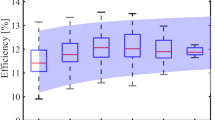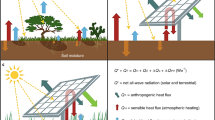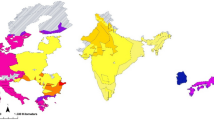Abstract
Renewable energy could often be land constrained by the diffuse nature of renewable resources. To relax land constraints, we propose the concept of ‘aglectric’ farming, where agricultural land will be sustainably shared for food and energy co-production. While wind turbines on agricultural land are already put into practice, solar power production on agricultural land is still under research. Here, we propose photovoltaic systems that are suitable for installation on agricultural land. Adjusting the intensity, spectral distribution and duration of shading allows innovative photovoltaic systems to achieve significant power generation without potentially diminishing agricultural output. The feasibility of solar aglectric farms has been proven through shadow modelling. The proposed solar aglectric farms—used alone or in combination with regular solar parks or wind plants—could be a solution for a sustainable renewable economy that supports the ‘full Earth’ of over 10 billion people.
This is a preview of subscription content, access via your institution
Access options
Access Nature and 54 other Nature Portfolio journals
Get Nature+, our best-value online-access subscription
$29.99 / 30 days
cancel any time
Subscribe to this journal
Receive 12 digital issues and online access to articles
$119.00 per year
only $9.92 per issue
Buy this article
- Purchase on Springer Link
- Instant access to full article PDF
Prices may be subject to local taxes which are calculated during checkout




Similar content being viewed by others
Data availability
The data used in this analysis were obtained from the references as noted. Any additional data needed to reproduce or support this work can be obtained from the corresponding author on reasonable request.
Code availability
The code required to reproduce this work is available from the corresponding author on reasonable request.
References
UN Department of Economic and Social Affairs World Population Prospects: The 2017 Revision—Key Findings and Advance Tables Working Paper No. ESA/P/WP/248 (2017).
Tilman, D. Food & health of a full Earth. Daedalus 144, 5–7 (2015).
Jacobson, M. Z. et al. 100% clean and renewable wind, water, and sunlight all-sector energy roadmaps for 139 countries of the world. Joule 1, 108–121 (2017).
Smil, V. Power Density: A Key to Understanding Energy Sources and Uses (MIT Press, 2015).
MacKay, D. J. C. Solar energy in the context of energy use, energy transportation and energy storage. Phil. Trans. R. Soc. A 371, 20110431 (2013).
Capellán-Pérez, I., de Castro, C. & Arto, I. Assessing vulnerabilities and limits in the transition to renewable energies: land requirements under 100% solar energy scenarios. Renew. Sust. Energy Rev. 77, 760–782 (2017).
Macilwain, C. Energy: supergrid. Nature 468, 624–625 (2010).
Denholm, P., Hand, M., Jackson, M. & Ong, S. Land use Requirements of Modern Wind Power Plants in the United States Technical Report NREL/TP-6A2-45834 (National Renewable Energy Laboratory, 2009).
Ong, S., Campbell, C., Denholm, P., Margolis, R. & Heath, G. Land-Use Requirements for Solar Power Plants in the United States Technical Report NREL/TP-6A20-56290 (National Renewable Energy Laboratory, 2013).
Gençer, E. et al. Directing solar photons to sustainably meet food, energy, and water needs. Sci. Rep. 7, 3133 (2017).
Armstrong, A., Nicholas, J. O. & Jeanette, W. Solar park microclimate and vegetation management effects on grassland carbon cycling. Environ. Res. Lett. 11, 074016 (2016).
Marrou, H., Guilioni, L., Dufour, L., Dupraz, C. & Wéry, J. Microclimate under agrivoltaic systems: is crop growth rate affected in the partial shade of solar panels? Agric. Meteorol. 177, 117–132 (2013).
Marrou, H., Dufour, L. & Wéry, J. How does a shelter of solar panels influence water flows in a soil–crop system? Eur. J. Agron. 50, 38–51 (2013).
Goetzberger, A. & Zastrow, A. On the coexistence of solar-energy conversion and plant cultivation. Int. J. Sol. Energy 1, 55–69 (1982).
Dupraz, C. et al. Combining solar photovoltaic panels and food crops for optimising land use: towards new agrivoltaic schemes. Renew. Energy 36, 2725–2732 (2011).
Dinesh, H. & Pearce, J. M. The potential of agrivoltaic systems. Renew. Sust. Energy Rev. 54, 299–308 (2016).
Valle, B. et al. Increasing the total productivity of a land by combining mobile photovoltaic panels and food crops. Appl. Energy 206, 1495–1507 (2017).
Fraunhofer Institute for Solar Energy Systems. Harvesting the Sun for power and produce—agrophotovoltaics increases the land use efficiency by over 60 percent. Fraunhofer ISE https://www.ise.fraunhofer.de/en/press-media/press-releases/2017/harvesting-the-sun-for-power-and-produce-agrophotovoltaics-increases-the-land-use-efficiency-by-over-60-percent.html (2017).
Agrawal, R. & Singh, N. R. Solar energy to biofuels. Annu. Rev. Chem. Biomol. Eng. 1, 343–364 (2010).
Agrawal, R. & Mallapragada, D. S. Chemical engineering in a solar energy‐driven sustainable future. AIChE J. 56, 2762–2768 (2010).
Al-Musleh, E. I., Mallapragada, D. S. & Agrawal, R. Continuous power supply from a baseload renewable power plant. Appl. Energy 122, 83–93 (2014).
Nickerson, C., Ebel, R., Borchers, A. & Carriazo, F. Major Uses of Land in the United States, 2007 (USDA Economic Research Service, 2011).
Ordóñez, J. et al. Analysis of the photovoltaic solar energy capacity of residential rooftops in Andalusia (Spain). Renew. Sust. Energy Rev. 14, 2122–2130 (2010).
Hong, T., Lee, M., Koo, C., Kim, J. & Jeong, K. Estimation of the available rooftop area for installing the rooftop solar photovoltaic (PV) system by analyzing the building shadow using hillshade analysis. Energy Procedia 88, 408–413 (2016).
Izquierdo, S., Montañés, C., Dopazo, C. & Fueyo, N. Roof-top solar energy potential under performance-based building energy codes: the case of Spain. Sol. Energy 85, 208–213 (2011).
World Energy Balances 2017: Overview (International Energy Agency, 2017).
The World Bank Agricultural Land (% of Land Area) (Food and Agriculture Organization, 2018); https://data.worldbank.org/indicator/AG.LND.AGRI.ZS?view=chart
The World Bank Forest Area (% of Land Area) (Food and Agriculture Organization, 2018); https://data.worldbank.org/indicator/AG.LND.FRST.ZS?view=chart
Sun, X., Khan, M. R., Deline, C. & Alam, M. A. Optimization and performance of bifacial solar modules: a global perspective. Appl. Energy 212, 1601–1610 (2018).
Zhao, B., Sun, X., Khan, M. R. & Alam, M. A. Purdue University bifacial module calculator (PUB). nanoHUB https://nanohub.org/resources/pub (2018).
Khan, M. R., Hanna, A., Sun, X. & Alam, M. A. Vertical bifacial solar farms: physics, design, and global optimization. Appl. Energy 206, 240–248 (2018).
Ulavi, T. U., Davidson, J. H. & Hebrink, T. Analysis of a hybrid PV/T concept based on wavelength selective films. J. Sol. Energy Eng. 136, 031009 (2014).
Charalambous, P. G., Maidment, G. G., Kalogirou, S. A. & Yiakoumetti, K. Photovoltaic thermal (PV/T) collectors: a review. Appl. Therm. Eng. 27, 275–286 (2007).
Ilic, O. et al. Tailoring high-temperature radiation and the resurrection of the incandescent source. Nat. Nanotechnol. 11, 320–324 (2016).
Imenes, A. G. & Mills, D. R. Spectral beam splitting technology for increased conversion efficiency in solar concentrating systems: a review. Sol. Energy Mater. Sol. Cells 84, 19–69 (2004).
Yu, Z. J., Fisher, K. C., Wheelwright, B. M., Angel, R. P. & Holman, Z. C. PV mirror: a new concept for tandem solar cells and hybrid solar converters. IEEE J. Photovolt. 5, 1791–1799 (2015).
McCree, K. J. The action spectrum, absorptance and quantum yield of photosynthesis in crop plants. Agric. Meteorol. 9, 191–216 (1971).
POWER Project Data Sets (NASA Langley Research Center, 2018); https://power.larc.nasa.gov/
Jose, B. S. Agroforestry for ecosystem services and environmental benefits: an overview. Agrofor. Syst. 76, 1–10 (2004).
State Energy Data System (SEDS): 1960–2014 (Complete) (US Energy Information Administration, 2017); https://www.eia.gov/state/seds/seds-data-complete.php?sid=US#Consumption
Agrawal, R. & Singh, N. R. Synergistic routes to liquid fuel for a petroleum‐deprived future. AIChE J. 55, 1898–1905 (2009).
Agrawal, R., Singh, N. R., Ribeiro, F. H. & Delgass, W. N. Sustainable fuel for the transportation sector. Proc. Natl Acad. Sci. USA 104, 4828–4833 (2007).
Net Generation by State by Type of Producer by Energy Source (US Energy Information Administration, 2016); https://www.eia.gov/electricity/data/state/
Energy Flow Charts (Lawrence Livermore National Laboratory, 2016); https://flowcharts.llnl.gov/commodities/energy
How Much Electricity is Lost in Transmission and Distribution in the United States? (US Energy Information Administration, 2017); https://www.eia.gov/tools/faqs/faq.php?id=105&t=3
Annual Energy Outlook 2016 (US Energy Information Administration, 2017).
Poullikkas, A. Sustainable options for electric vehicle technologies. Renew. Sust. Energy Rev. 41, 1277–1287 (2015).
An, F. & Santini, D. Assessing Tank-to-Wheel Efficiencies of Advanced Technology Vehicles Technical Paper 2003-01-0412 (SAE International, 2003).
Singh, N. R., Delgass, W. N., Ribeiro, F. H. & Agrawal, R. Estimation of liquid fuel yields from biomass. Environ. Sci. Technol. 44, 5298–5305 (2010).
Efroymson, R. A. et al. 2016 Billion-Ton Report: Advancing Domestic Resources for a Thriving Bioeconomy, Volume 2: Environmental Sustainability Effects of Select Scenarios from Volume 1 No. ORNL/TM-2016/727 (Oak Ridge National Laboratory, Argonne National Laboratory, National Renewable Energy Laboratory & Pacific Northwest National Laboratory, 2017).
Parsell, T. et al. A synergistic biorefinery based on catalytic conversion of lignin prior to cellulose starting from lignocellulosic biomass. Green Chem. 17, 1492–1499 (2015).
Stein, J. S., Holmgren, W. F., Forbess, J. & Hansen, C. W. PVLIB: open source photovoltaic performance modeling functions for Matlab and Python. In 2016 IEEE 43rd Photovoltaic Specialists Conference (PVSC) 3425–3430 (IEEE, 2016).
Acknowledgements
This work is supported by the Sustainable Food, Energy, and Water Systems programme, funded by National Science Foundation Research Traineeship Award 1735282.
Author information
Authors and Affiliations
Contributions
C.K.M. and R.A. developed the initial land-area estimation model, conceptualized the aglectric PV systems and estimated the power output of these systems. Y.L. refined and finalized the land-area estimation model. Y.L. and R.A. analysed the synergy of PV and wind aglectric farming, drafted the associated results and compiled the author contributions. A.P. developed the shadow depth model and simulation with consultation from P.B. and E.K.G. R.G.E. provided the schematics of land-area estimation and innovative PV systems. R.A. directed the overall research. All authors assisted in drafting and editing the final manuscript.
Corresponding author
Ethics declarations
Competing interests
The authors declare no competing interests.
Additional information
Publisher’s note Springer Nature remains neutral with regard to jurisdictional claims in published maps and institutional affiliations.
Supplementary information
Supplementary Information
Supplementary Notes 1–5, discussion, Tables 1–6, methods, Fig. 1 and references 1–19.
Rights and permissions
About this article
Cite this article
Miskin, C.K., Li, Y., Perna, A. et al. Sustainable co-production of food and solar power to relax land-use constraints. Nat Sustain 2, 972–980 (2019). https://doi.org/10.1038/s41893-019-0388-x
Received:
Accepted:
Published:
Issue Date:
DOI: https://doi.org/10.1038/s41893-019-0388-x
This article is cited by
-
Regional conditions shape the food–energy–land nexus of low-carbon indoor farming
Nature Food (2022)
-
Do agrivoltaics improve public support for solar? A survey on perceptions, preferences, and priorities
Green Technology, Resilience, and Sustainability (2022)
-
Assessment of plum rain’s impact on power system emissions in Yangtze-Huaihe River basin of China
Nature Communications (2021)



